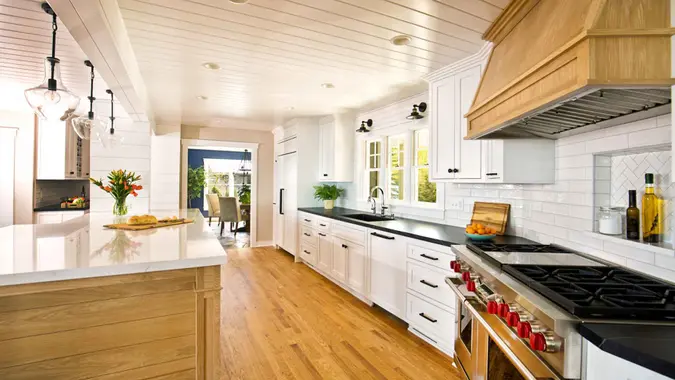Advertiser Disclosure
GOBankingRates works with many financial advertisers to showcase their products and services to our audiences. These brands compensate us to advertise their products in ads across our site. This compensation may impact how and where products appear on this site. We are not a comparison-tool and these offers do not represent all available deposit, investment, loan or credit products.
13 States Where You Can Buy a House on a $50K Salary or Less
 Written by
Virginia Anderson
Written by
Virginia Anderson
 Edited by
Amber Barkley
Edited by
Amber Barkley

Commitment to Our Readers
GOBankingRates' editorial team is committed to bringing you unbiased reviews and information. We use data-driven methodologies to evaluate financial products and services - our reviews and ratings are not influenced by advertisers. You can read more about our editorial guidelines and our products and services review methodology.

20 YearsHelping You Live Richer

Reviewed by Experts

Trusted by Millions of Readers
In June 2020, the median sales price of homes in the U.S. was $317,100. Fast-forward just four years, and the median home sales price is now $412,300 — a massive 30% jump in value.
Unfortunately, wages aren’t growing quickly enough to keep up with home price increases. In June 2020, the average full-time worker earned $1,008 weekly. Today’s full-time employees earn an average of $1,151 weekly — a rise of 14.2%. The increase in house prices outpaces earnings, making it harder for many to afford a home, especially first-time homebuyers who don’t already have equity in an existing house or a sizable down payment to offer.
High interest rates aren’t helping, either. Current interest rates for a 30-year mortgage average 6.49%, compared with 2.99% in July 2020. That drives up monthly mortgage payments even further, making borrowing much more expensive.
However, the housing market isn’t all bad news for homebuyers. In some states, you may still be able to afford a home, even if your household income is $50,000 or less. States with affordable housing also generally have a lower cost of living, so groceries, utilities and transportation costs may be within your budget.
Take a look at these 13 states where you can afford a home on a $50,000 salary or less, according to data from a recent GOBankingRates study.
West Virginia
- Minimum salary needed to comfortably afford a home: $32,418
- 2024 average home value: $155,080
- Overall cost of living: 20.6% cheaper than the national average
- Groceries: 4.2% cheaper than the national average
- Healthcare: 27% more expensive than the national average
- Utilities: 14.1% cheaper than the national average
- Transportation: 9.9% cheaper than the national average
Mississippi
- Minimum salary needed to comfortably afford a home: $35,674
- 2024 average home value: $170,653
- Overall cost of living: 21.3% cheaper than the national average
- Groceries: 5.1% cheaper than the national average
- Healthcare: 1.9% more expensive than the national average
- Utilities: 2.9% cheaper than the national average
- Transportation: 16.6% cheaper than the national average
Louisiana
- Minimum salary needed to comfortably afford a home: $40,813
- 2024 average home value: $195,240
- Overall cost of living: 10.1% cheaper than the national average
- Groceries: 7.3% cheaper than the national average
- Healthcare: 13.2% more expensive than the national average
- Utilities: 10.1% cheaper than the national average
- Transportation: 8.2% more expensive than the national average
Kentucky
- Minimum salary needed to comfortably afford a home: $41,058
- 2024 average home value: $196,412
- Overall cost of living: 17.7% cheaper than the national average
- Groceries: 5.8% cheaper than the national average
- Healthcare: 2.2% more expensive than the national average
- Utilities: 7.1% cheaper than the national average
- Transportation: 10.9% cheaper than the national average
Arkansas
- Minimum salary needed to comfortably afford a home: $41,467
- 2024 average home value: $198,364
- Overall cost of living: 22.5% cheaper than the national average
- Groceries: 7.3% cheaper than the national average
- Healthcare: 7.9% cheaper than the national average
- Utilities: 4.4% cheaper than the national average
- Transportation: 18.4% cheaper than the national average
Oklahoma
- Minimum salary needed to comfortably afford a home: $41,840
- 2024 average home value: $200,153
- Overall cost of living: 17.8% cheaper than the national average
- Groceries: 7.7% cheaper than the national average
- Healthcare: 13.8% more expensive than the national average
- Utilities: 0.3% cheaper than the national average
- Transportation: 10.8% cheaper than the national average
Iowa
- Minimum salary needed to comfortably afford a home: $44,394
- 2024 average home value: $212,367
- Overall cost of living: 19.9% cheaper than the national average
- Groceries: 5.6% cheaper than the national average
- Healthcare: 8.2% more expensive than the national average
- Utilities: 1.5% cheaper than the national average
- Transportation: 28.6% cheaper than the national average
Kansas
- Minimum salary needed to comfortably afford a home: $45,533
- 2024 average home value: $217,817
- Overall cost of living: 16.9% cheaper than the national average
- Groceries: 7% cheaper than the national average
- Healthcare: 3.9% more expensive than the national average
- Utilities: 4.4% more expensive than the national average
- Transportation: 20.7% cheaper than the national average
Alabama
- Minimum salary needed to comfortably afford a home: $45,572
- 2024 average home value: $218,004
- Overall cost of living: 15.9% cheaper than the national average
- Groceries: 5.6% cheaper than the national average
- Healthcare: 18.9% more expensive than the national average
- Utilities: 1.2% more expensive than the national average
- Transportation: 14.1% cheaper than the national average
Ohio
- Minimum salary needed to comfortably afford a home: $45,683
- 2024 average home value: $218,535
- Overall cost of living: 17.3% cheaper than the national average
- Groceries: 3.9% cheaper than the national average
- Healthcare: 11.3% cheaper than the national average
- Utilities: Same as the national average
- Transportation: 16.1% cheaper than the national average
Michigan
- Minimum salary needed to comfortably afford a home: $48,106
- 2024 average home value: $230,125
- Overall cost of living: 8.5% cheaper than the national average
- Groceries: 6.6% cheaper than the national average
- Healthcare: 15.2% cheaper than the national average
- Utilities: 0.1% more expensive than the national average
- Transportation: 15.1% more expensive than the national average
Indiana
- Minimum salary needed to comfortably afford a home: $48,347
- 2024 average home value: $231,278
- Overall cost of living: 16.3% cheaper than the national average
- Groceries: 7.1% cheaper than the national average
- Healthcare: 5.6% cheaper than the national average
- Utilities: 2.8% cheaper than the national average
- Transportation: 14.6% cheaper than the national average
Missouri
- Minimum salary needed to comfortably afford a home: $49,921
- 2024 average home value: $238,808
- Overall cost of living: 14.4% cheaper than the national average
- Groceries: 5.1% cheaper than the national average
- Healthcare: 4.3% more expensive than the national average
- Utilities: 1.5% cheaper than the national average
- Transportation: 13.8% cheaper than the national average
Cost of living information was sourced from Sperling’s BestPlaces.
More From GOBankingRates
Share This Article:




You May Also Like

One Home Upgrade That Almost Always Pays Off, According To an HGTV Star
November 14, 2025
5 min Read

5 Florida Beach Towns To Buy Property in the Next 5 Years, According to Real Estate Agents
November 13, 2025
5 min Read

I'm a Real Estate Agent: Here Are 5 Renovations Buyers Want the Most in 2026
November 10, 2025
5 min Read


It Costs More Than $67K Just To Sell a Home -- These 6 Expenses Give You the Best ROI
November 07, 2025
5 min Read




Barbara Corcoran: If Mortgage Rates Hit This Number, the Market Will 'Go Ballistic'
November 10, 2025
5 min Read




Make your money work for you
Get the latest news on investing, money, and more with our free newsletter.
By subscribing, you agree to our Terms of Use and Privacy Policy. Unsubscribe at any time.


Thanks!
You're now subscribed to our newsletter.
Check your inbox for more details.



Sending you timely financial stories that you can bank on.
Sign up for our daily newsletter for the latest financial news and trending topics.
For our full Privacy Policy, click here.
Looks like you're using an adblocker
Please disable your adblocker to enjoy the optimal web experience and access the quality content you appreciate from GOBankingRates.
- AdBlock / uBlock / Brave
- Click the ad blocker extension icon to the right of the address bar
- Disable on this site
- Refresh the page
- Firefox / Edge / DuckDuckGo
- Click on the icon to the left of the address bar
- Disable Tracking Protection
- Refresh the page
- Ghostery
- Click the blue ghost icon to the right of the address bar
- Disable Ad-Blocking, Anti-Tracking, and Never-Consent
- Refresh the page





